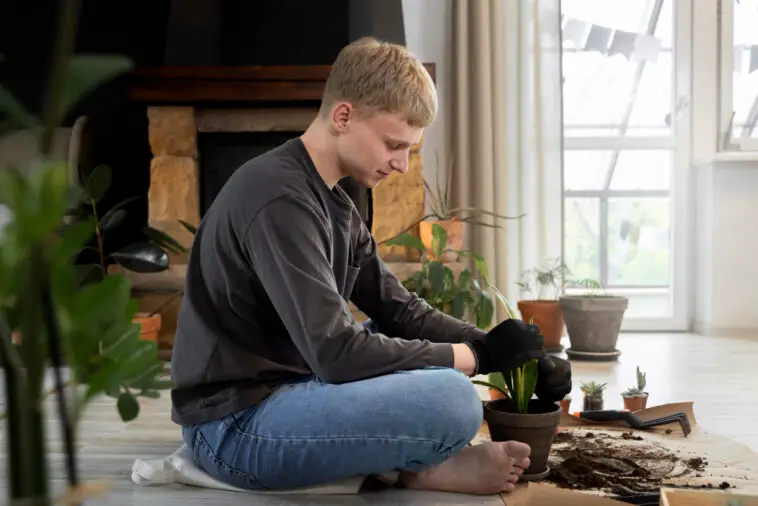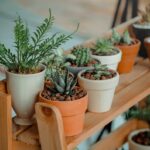The acronym LECA stands for Lightweight Expanded Clay Aggregate. Although it may appear to be incredibly difficult to understand, it is actually pretty simple. In its most basic form, Leca is a growth medium, similar to soil, in which you may cultivate the plants you want to grow. Leca is a set of baked clay balls that stretch when submerged in water.
Because soil already has nutrients, tending to your plants’ nutritional needs is simplified when you work with soil. On the other hand, leca does not have any nutrients in its composition. Consequently, you could be questioning why on earth you would ever contemplate utilizing this for the purpose of cultivating your plants.
This article will enlighten you on such specifics, so keep reading. You’ll gain an understanding of why it’s helpful once you’ve finished reading this article, and after that, you might even decide to give it a shot yourself.
We’ll cover the following subjects in this guide:
- What is Leca, exactly?
- Why is Leca beneficial to your plant’s growth?
- In Leca, how do you fertilize your plants?
So, let’s get started! I have a lot of positive things to say about Leca, and I can’t wait to share them with you!
Read more: When is the best time to water your houseplants?
Table of Contents
What is Leca, exactly?
Lightweight expanded clay aggregate, or Leca for short, was something I brought up right at the beginning of this explanation. In layman’s terms, this implies that you have baked clay balls that absorb a little water and then expand somewhat. The water that has been absorbed by the clay balls may be utilized to water plants.
Leca, on the other hand, is nothing more than a collection of clay balls and does not have any nutrients of its own as soil does. The only thing they do is take in a small amount of water and then grow as they are doing so. You’ll need to add any fertilizers your plants require to the water.
This doesn’t help you comprehend why Leca is beneficial, so let’s improve that!
Read more: Smart Gravel for houseplants?
Why is Leca beneficial to your plant’s growth?
Since you now know that Leca is nothing more than a collection of clay balls that get larger over time, you might be asking how this can possibly be beneficial to my plants. So, here’s a list of the advantages, which we’ll go over one by one.
- It will be less of a hassle to water your plants.
- A lower possibility of root rot
- There is a lower chance of being infested by pests.
- It is simple to “check in” on how your plants are doing.
It will be less of a hassle to water your plants.
The most crucial aspect of cultivating your plants in Leca is to ensure that the roots do not become saturated with water at any point. Using Leca, you may build a fake bottom and lift the roots of your plants from the bottom of the container.
After that, you may begin adding water until it is at a level that is just below the roots of the plants. Your clay balls might begin to absorb water in the container while keeping the roots away from it.
Your plants now have the ability to determine for themselves the amount of water that they require. Your plants are able to drink the water that has been absorbed into the clay balls since they aren’t always sitting in water, as is typically the case when using soil. Instead, they are able to sip on the water.
If your plants are suffering from extreme dehydration, they will begin to grow toward the water that is located at the bottom of the pot so that they may drink directly from it.
Read more: The five simplest houseplants for beginners
Giving your plants authority
When compared to plants growing in soil, plants living in Leca have the ability to control when they sip water, which is a significant distinction. When you utilize Leca, you are placing the responsibility of the plant’s care into the hands of the plant itself.
Ultimately, the plant understands what it desires and needs to survive. You determine what the plant wants and needs when you utilize soil. This may be quite challenging at times, especially for those who are just starting out.
A lower possibility of root rot
When utilizing soil, you water when the soil feels dry or the plant appears to be in a specific state. After using Leca, watering is made considerably easier because you only need to do so when the water that was previously in the pot has evaporated. Either the plant has absorbed it all via its roots or the clay balls have done so.
Even if the clay balls are still completely saturated with water, adding more water to the soil around the plant will not cause it to become overwatered. Because it is up to the plant to decide when and how much water it needs, your plant won’t suffer from overwatering. If you continue to water the plant after the soil has already been saturated, there is a risk that you might overwater it and kill the plant.
Because the Leca allows a lot of air spaces between the clay balls, there is also a much reduced possibility of root rot occurring. This assists in delivering oxygen that is necessary to the roots of your plants. A shortage of oxygen at your plants’ roots is a major cause of root rot. Leca fixes the problem, and root rot is no longer a concern.
Read more: Do different kinds of soil make a difference for the health of your plant?
There is a lower chance of being infested by pests.
As previously said, you water your plants in Leca when there is no more water at the bottom of the pot. The plant will determine for itself when it needs to drink, helping it to avoid being overwatered. The risk of the plants developing root rot is quite minimal due to the fact that it is very impossible to overwater them in this scenario.
This ensures that insects will not be drawn to the decaying roots and soil of the plant. Fewer bugs equal fewer pests. Another reason that Leca lowers pests is that, unlike soil, it is not a living growth medium. Soil is made up of organic stuff that contains nutrients and is “living.”
This indicates that it may also contain nutrients that are beneficial to insects. Insects typically spread and cause illnesses in plants, so eliminating them completely reduces your chances of dealing with a sick plant.
In reality, the Zebrina and Polly, two of my Alocasias, were unwell and their roots were decaying. This attracted insects, which nearly destroyed both plants. They’ve healed and are now growing like previously after switching to Leca and cleaning them once a week. Those plants will almost certainly never touch soil again.
Read more: Bottom Vs Top Watering: Which Is Better For Your Plant?
It is simple to “check-in” on your plants.
The only time you’ll see the roots while growing your plants in soil is when you’re repotting them. You won’t know what the roots look like or how they’re doing between planting and repotting them.
However, if you opt to cultivate your plants in Leca, you will be able to inspect the roots every day. Because different environments might be stressful for different types of plants, you should avoid doing this. Every week or once every two weeks, I give the majority of my plants that thrive in Leca a thorough cleaning. In the course of this procedure, I also make it a point to thoroughly clean, or at the very least rinse, the Leca.
This offers me the chance to examine the condition of the plant’s roots, which is really helpful. I am able to monitor the development of the roots and make necessary adjustments to the position of the plant within the container based on my findings.
The ease with which you can “check-in” on your plant is what enabled me to save my Alocasias from imminent death. As soon as I noticed rotten roots, I was able to cut them off, and by thoroughly cleaning the plant, I was able to stop any additional rotting from occurring. It took a lot of work, but my plants are now flourishing again.
Read more: Can you water your houseplants with tap water?
In Leca, how do you fertilize your plants?
As I previously stated, Leca does not offer your plants with the nutrients they require to flourish correctly. Only the watering of your plants will be taken care of by Leca. As a result of this, you will be responsible for adding the nutrients to the water on your own. There are a number of different types of fertilizer that can be beneficial to your plants, but the majority of conventional hydroponics fertilizer works just fine.
These may take the form of growth hormones or fertilizer and are intended to encourage quicker and more robust root development. Because I do not have any expertise with them, I always use a hydroponics fertilizer that is more generic. Because this has been successful up to this point, you ought to give some thought to putting it to use yourself.
Regarding hydroponic nutrient (fertilizer)
Hydroponics nutrients, sometimes known as fertilizer, offer a variety of unique components that are not present in conventional plant fertilizer. These components are not necessary for the production of standard plant fertilizer because the plant will obtain these nutrients from the soil.
Because Leca does not contain any nutrients on its own, the hydroponics fertilizer must have them in order to maintain your plant healthy. Because it does not contain these essential components, standard fertilizer cannot be used on plants grown in Leca. This is the reason for this restriction.
Read more: Can you take a houseplant outside?
Conclusion
Leca is an abbreviation for Lightweight Expanded Clay Aggregate. In essence, they are baked clay balls that expand when soaked in water. They’re fantastic as a growing medium for plants since they make watering easier, decrease insect threats, and allow you to simply “check-in” on your plants.
The most essential thing to remember while growing plants in Leca is to never let their roots sit in water and to use a hydroponics fertilizer of any kind. This manner, your plants obtain the nutrients they require and may drink when thirsty. It is my hope that the advantages that I have outlined in this article have piqued your interest enough to warrant giving it a shot. I strongly advise you to use it!
I appreciate you taking the time to read my article. I really hope that this information is of use to you in maintaining the health and beauty of your plants.
Frequently Asked Questions
Do I need to use fertilizer when using Leca?
Yes. Because leca does not naturally contain any nutrients, you will need to feed these through the watering process. You cannot use fertilizer designed for plants grown in soil in this environment; instead, you will require fertilizer designed specifically for use in semi-hydroponic systems.
Do I need to clean the Leca?
Your leca balls may occasionally become white due to the calcium in the water you’re using. It’s a good idea to wash this off. You run the risk of getting algae on your Leca if you use a glass vase instead of a pot since it lets in more light than a pot would. You need to remove this substance by immersing the Leca balls in water and washing them.
How do I avoid algae?
Algae can only develop when the light shines on the drenched Leca. You won’t have to worry about developing algae on the wet Leca as long as you block the sun’s rays from reaching it.
How often should you water plants in Leca?
Water your plants in Leca just until the clay balls are unable to absorb any more water from the bottom of the container. When this occurs, it is time to give your plant another drink of water. In most cases, you should do this once every two weeks; however, the frequency of this task is entirely contingent on the amount of Leca that you are utilizing, the size of your pot, and the amount of moisture that your plant is able to absorb.
Where can you buy Leca pebbles?
Leca, or clay balls, are available at practically all garden centers. You may also buy them online from a variety of merchants. You shouldn’t have any trouble locating them.
What are Leca pebbles?
Lightweight expanded clay aggregate is what “leca” stands for when it’s referred to as an abbreviation. Although it may appear to be incredibly difficult to understand, it is actually pretty simple. In its most basic form, Leca is a growth medium, similar to soil, in which you may cultivate the plants you want to grow. Leca is a set of baked clay balls that expand when submerged in water.
What does Leca mean?
The acronym LECA stands for Lightweight Expanded Clay Aggregate. It’s something that plants may use as a growth medium.
Read more: Does the direction of the sun affect your houseplant?



